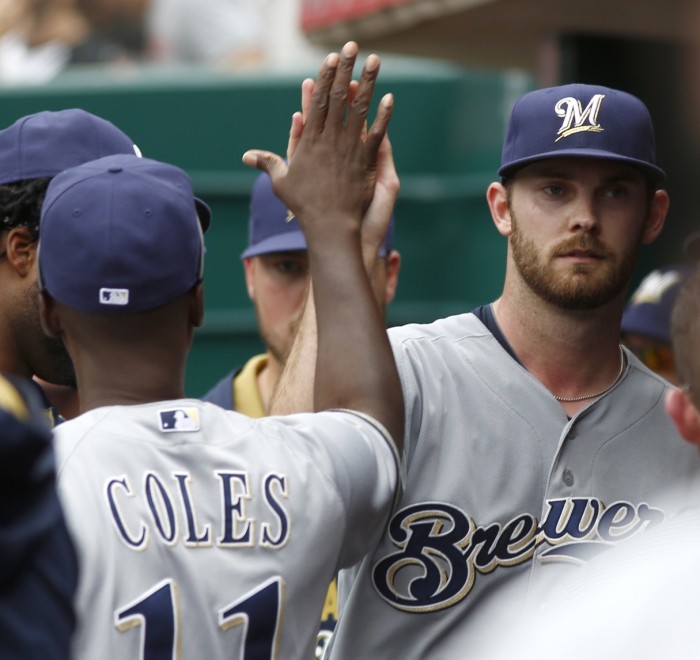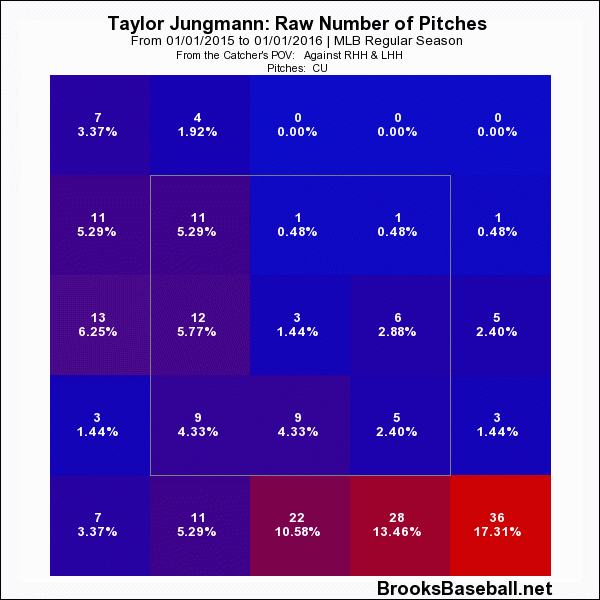Pick a means of measuring a pitcher’s performance, and you’ll find that Taylor Jungmann tops all other current Brewers starters in it. ERA, FIP, xFIP, DRA, cFIP — they all think more highly of him, to varying extents, than they do of Matt Garza, Kyle Lohse, Jimmy Nelson, or Wily Peralta. I’ve written about his ability to prevent baserunners from coming around to score, while J.P. Breen has covered his improvements with command. There’s another fascinating element of Jungmann’s play, though, which few have noticed.
Last year in the minors, Jungmann fanned a fair amount of batters. Across 153.2 innings in Double-A and Triple-A, he struck out 22.4 percent of the men who faced him — a rate that helped him compile a 3.57 ERA in those games. At the major-league level, he’s roughly stuck with that trend, putting 20.5 percent of the opposition down on strikes. Oddly, though, he hasn’t put up a low contact rate (82.0 percent), or a high swing rate (43.1 percent). His swinging-strike rate of 7.8 percent thus falls short of the 9.8 percent MLB average. How, then, has he collected so many strikeouts?
Simple: He’s thrown a boatload of called strikes. Per Baseball-Reference, his looking-strike rate of 19.3 percent comfortably surpasses the major-league average of 17.1 percent. The consequent 32.1 percent looking strikeout rate (as a percentage of overall punchouts) would place him 16th in the National League, if he qualified. The capacity to ring batters up in this way has been crucial to Jungmann’s 2015 season.
As with most Brewers hurlers, Jungmann owes a fair amount of this success to his catchers. His zone rate of 45.9 percent and zone-swing rate of 60.6 percent have combined to give him an 18.1 percent expected looking-strike rate — a not-insignificant dropoff from his results. Because he’ll presumably continue to pitch to Jonathan Lucroy (for now, at least), one should expect Jungmann to likely continue outperforming his peripherals here.
With that said, a looking-strike rate of 18.1 percent deserves respect. Even if Jungmann does regress to that level, he’ll still probably strike out a respectable quantity of hitters. He deserves credit for what he’s done, as does the pitch that’s done it — his four-seam fastball. Among all the members of his repertoire, only that has an above-average rate of called strikes:
| Pitch Type | LookStr% |
|---|---|
| Fourseam | 22.7% |
| Sinker | 16.9% |
| Change | 9.6% |
| Curve | 18.8% |
That offering has come across the plate more often than any other, with a 46.2 percent zone rate. Jungmann has generally concentrated it low in the zone, and for good reason:
The opposition has simply ignored Jungmann’s low four-seamers, which has been to their detriment. Why would they choose to do so? It may have something to do with Jungmann’s curveball, which he’s used most often when ahead in the count (33.2 percent, compared to 20.7 percent overall), and which he’s continually buried in the dirt:
Fearing a whiff (which those curves often induce), batters might lay off a low pitch, only to watch it go past for a strike.
Jungmann’s delivery may also have a hand in this. In the words of Bernie Pleskoff, he relies heavily on “adding deception”, via an “awkward and herky-jerky” throwing motion; as far as outcomes go, called strikes may be the most deceptive of them all. If hitters can’t pick up on the pitch, they’ll most likely decline to swing at it — a decision that works in Jungmann’s favor.
Whatever the cause, Jungmann’s called strikes should continue. He’ll possess an All-Star framer behind the plate, a formidable, fastball-curveball combination, and an unusual delivery, all of which have seemingly contributed to this. Although they aren’t as sexy as swinging strikes, looking strikes can serve the same purpose and can grant the same prosperity. They’ve certainly done that for Jungmann. Keeping it up will help him remain atop the Milwaukee rotation for the remainder of 2015.



1 comment on “Jungmann Continues To Catch Hitters Looking”